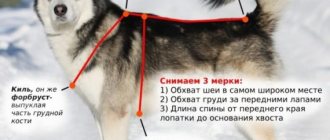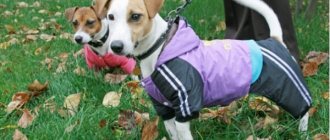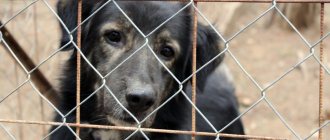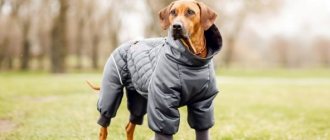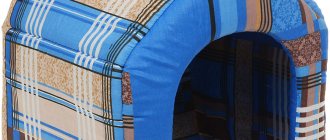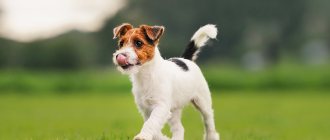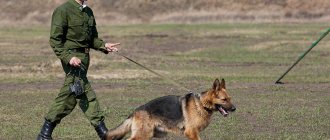How to choose a harness for a dog. In this article you will learn how to choose a harness for your dog.
First, a few words about what a harness is. This is one of the types of walking or training equipment. The difference from a collar is that it is worn not on the neck, but on the body of the animal. The harness can be made of leather, nylon, canvas, or other durable material that can withstand heavy loads. For small breeds, the harness can be made of fabric or velor. The models are generally similar: they cover the chest, pass between the front legs and are fastened on the back of the animal.
How to put a harness on a dog, step by step guide
An owner who has only recently acquired a pet may face categorical rejection. He will resist in every possible way, trying to free himself from the tight harness. This is completely natural, because the dog may not immediately appreciate all its advantages. But if you do the right thing, then over time he will rejoice at the sight of the harness in your hands, because for him it will become a symbol of a walk and a fun time.
Not knowing how to put a harness on a dog can waste a lot of time; some owners, after several unsuccessful attempts, generally consider it as a useless accessory, depriving them of the many benefits it can provide. To put it on quickly, use the following guide:
- If your pet is disobedient and refuses to obey, secure it between your legs in the back area.
- Before putting a harness on your dog for the first time, distract him with a favorite treat or toy. If even at this stage you are unable to achieve the required results, then conduct several exercises for endurance;
- Place the ring-shaped part of the closed-type harness around the chest in front of the paws; its dimensions may vary depending on the design of the accessory;
- Next, position the strap along the top of the case to the desired position, thereby limiting the space between the jumper and the closed circle. The right paw is threaded into the area between the closed circle and the strap;
- The jumper passes through the surface of the chest, a strap is put on the right side, after which the loose part must be threaded through the armpit of the left paw. Next, all that remains is to fasten all the belts.
After you manage to tie the dog harness, release it, adjust it and make sure that the accessory does not choke your pet and fits firmly enough to his body. The last step is to check the fastened parts. Even using step-by-step instructions on how to put a harness on a dog, you may encounter certain difficulties. Take your time, perform all the steps sequentially, and do not hesitate to ask questions to familiar dog breeders or store sellers. Harnesses may vary in design, but the principles remain the same.
Leather products
Leather collars look extremely aesthetically pleasing; they are chosen by owners who attach importance to the appearance of their pet. High-quality leather products have double or triple stitching, thanks to which they do not wear out for a long time.
When choosing a collar, you should look at its inner surface. There should be no threads or knots, these are signs of marriage. Poor-quality firmware can injure the animal’s skin.
The only significant disadvantage of such collars for dachshunds is their high cost. If the product is of high quality, it can cost several thousand rubles.
Types of harnesses
The modern market for accessories for dog breeders is very diverse and is represented by a large number of products of different types. They can be divided into groups according to size, type of materials used, and purpose. Some models are complemented by special pockets for cargo, fastening rings for harnesses or other elements that expand the functionality of the product. When you go to a pet supply store, you can find the following harnesses:
- Walking. The fastening ring on them is fixed in the withers area. They are well suited for daily walks, which is especially convenient with pets. The small ones are equipped with additional straps;
- Towing. Their purpose is sports competitions. Such harnesses are worn on hyperactive dogs prone to non-stop forward movement. With their help, they train the chest muscles for German Shepherds and other breeds. They use the most durable belts;
- With loads. If your dog requires increased physical activity, use weighted harnesses. Some models are complemented by weights sewn inside, others have pockets with metal bars with which the weight can be adjusted. Their use is advisable for strengthening muscle mass after fractures.
Pay attention to the article types of harnesses.
Progressive dog handlers never wear a harness for every walk and activity. The load should be uniform and appropriate. It is most convenient to train your pet at a very early age, at the same time as a collar; in this case, you will need a miniature harness, ra
at this stage, you can accustom him to the idea that harnesses and other types of equipment are primarily associated with walks and having fun.
Tips and tricks
Device for the pet's comfort All the owner's attention should be focused on how the dog feels in the harness.
The equipment, like the suit, should fit well on the figure. You must put the harness on your pet very carefully so as not to scare him. It is best to distract him with a toy, and after the procedure is completed, treat him with a treat.
For reference! Quality products are produced by such companies as Perfect Fit, Ruffwear, Zero DC Short Harness, Haqihana, Niggeloh Follow, Ferplast.
The most important thing is the dog’s comfort. She should be comfortable wearing a harness and walking in it. This remedy will relieve animals from problems with the spine and neck that arise due to tight and heavy collars.
Anatomically correct walking harnesses for dogs
A little history
A Swedish study found that behavioral problems in dogs (such as aggression, excessive barking and fearfulness) were often caused by back pain. 63% of dogs out of 424 subjects were identified with such diseases. The damaged parts of the spine were: lumbar - 73%, thoracic - 67%, cervical - 27%. Of these, 56% of dogs had behavior problems (42% with aggression and stress, and 13% with fearfulness). The data is taken from A. Hallgren's book “Behavioral Problems - or Back Pain?”, in which you can learn more about the results of the study.
Collars
The use of planers and nooses can lead to serious damage to the cervical vertebrae, neck muscles, irritation and pinching of the throat. Therefore, if you lead your dog on a collar, it should be wide and soft ( ).
Pulling on the leash
A direct relationship has been established between pulling on the leash and back problems. And here the neck and throat suffer. 91% of dogs with neck injuries were subjected to strong tugs on the leash or pulled on the leash for a long time. If your dog is still pulling on a leash, I recommend, firstly, switching to a harness, and, secondly, teaching the dog to walk on a slack leash, of course, with PP (positive reinforcement). If you don’t know how to do this, contact the Gilda dog training school for help.
Harnesses
I would like to briefly go over the most important points in choosing a good harness, which guided me when I was choosing a harness for my dog. Briefly, because you can find detailed and long articles on choosing a harness on the Internet. 1. Harness shape
The most important thing to pay attention to here is that the front strap of the harness should not lie on the neck (in Fig. 1, 2, 3 the strap will be on the dog’s neck). Otherwise, the harness will no longer differ in any way from the collar, which means it will lose its usefulness. Those. It is important for us that nothing puts pressure on the dog’s neck. At the front, the anatomically correct harness has a Y-shape (as in Fig. 8). This shape protects the dog’s neck from the tension of the leash and does not injure it. From above, such a harness looks like the letter H (Fig. 7). This shape allows you to avoid stiffness of movement, and when the leash is pulled, it does not slip from the chest to the neck.
2. Harness straps
The harness straps, located behind the forelimbs (which encircle the dog’s body), should extend some distance from the shoulder so as not to rub the armpits and interfere with the movement of the limbs (Fig. 5). They should not be too narrow so as not to cut into the dog's body (Fig. 6).
3. Harness material
Choose a harness that is light, soft and smooth, durable and wear-resistant, following the contour of the dog’s body (Fig. 5-8). For example, a leather harness (Fig. 4) will not work at all, because it is rough and heavy.
4. Recommended companies:
Chain collars for exhibition
If a dog participates in exhibitions, its owner often purchases a metal collar. The chain attracts the attention of viewers and emphasizes the attractive appearance of the dachshund.
To correctly calculate the length of such a collar, you need to add 5 cm to the neck circumference. The steel product is removed before swimming and other water procedures.
When choosing a collar, you should pay attention to its links; they should be made of high-quality alloy. Chemical impurities in metal can irritate the animal's skin and fur. It is desirable that the links be welded, then they will withstand strong jerks. If there are gaps in them, dog hair can get in there, causing injury.
How to measure a dog when choosing a harness?
The main principle of the harness is to fit the dog's body tightly and correctly distribute the load. The straps should not move, sag or, on the contrary, cut into the skin too much. This is why it is so important to accurately determine the size of the harness.
To do this, you just need to know how to take measurements from a dog for a harness. After taking several measurements, you can buy ammunition for your pet even without trying it on in the store.
- Measure the circumference of your dog's neck (you can measure directly under the collar). The front point should be located on the keel - the protruding bone under the dog's neck, the back point - on the edge of the front shoulder blades.
- Now we determine the girth of the chest (place the measuring tape slightly behind the front legs, focusing on the widest part of the chest), keep in mind that you should throw a couple of centimeters over the loose fit.
- The dimensions of dog harnesses imply a slight play of a few centimeters, which you can adjust with belts, but still try to take the measurements as accurately as possible.
How to measure a dog to select specialized harnesses?
Harnesses for animal pulling or sledding have additional straps, which, of course, must also be fitted perfectly. Need to measure:
- Length of the back (from the front edge of the shoulder blades to the base of the tail).
- Chest circumference behind the front legs.
- Neck circumference at the widest point - from the keel to the place where the anterior edge of the shoulder blade begins
In the online store you can choose the size of the harness using two classic measurements - neck and chest circumference. However, if you decide to sew ammunition to order, the ability to take measurements correctly will come in handy.
How to make a purchase in our store?
Once you know how to measure your dog for a harness, you can easily shop online. After taking the necessary measurements, choose the model that is most suitable for your pet. However, we understand that sometimes two parameters are not enough to determine the size of the harness. Individual features of the body structure may make adjustments. If the purchase does not suit your pet, you can return it or exchange it for a more convenient model.
After receiving the product, be sure to try it on:
- The belt should not slip around the dog's neck.
- Two fingers should fit between the neck strap and the skin.
- The back straps should be slightly away from the dog's front paws so as not to rub the skin when moving.
- Pull the leash - the front strap should not slide onto the trachea!
And only after you make sure that the harness fits perfectly, you can start training and active walks. We wish your four-legged friend good health and success!
Rules for using the “planer”
Parfors for a dog is a method of training it. It may be needed, for example, when a pet does not obey during a walk and pulls on the leash. You cannot use a strict collar for a long time, much less constantly.
To accustom your pet to the “grinder”, at first you should wear it for a short time at home. Training in such equipment should last no more than an hour. If you wear the product for a long time, it may irritate your dog's skin.
During a walk, if the animal tries to rush forward, you should briefly pull it by the “strach”. This will stop the pet and make it obey its owner. This way the dachshund will understand that he has done something inappropriate, and over time he will learn to behave correctly.
But you shouldn’t wear a “strogach” for every walk, so that the animal does not develop an association of pain and irritation associated with the street. In the worst case scenario, the dog may become fearful.
After training, it is worth removing the “stringer” from your pet to protect it from accidental injury. There are cases where dogs left unattended in such collars for long periods of time have seriously injured themselves, resulting in death.
If the dachshund has learned to be obedient, you can part with the “handler.” If everything is done correctly, the pet will obey the owner even in a regular soft collar.
Types of harnesses
Pet stores offer a huge number of devices, and it’s easy to get confused by this variety. To make the task of choosing a harness easier, let’s look at what varieties are available on the market and who they are suitable for.
Walking
It's also universal. The most popular type of product, which is bought “for every day”.
They are made of leather or nylon tape in the form of belts connected by rings, and a fastening ring or carabiner is located at the withers.
There are usually no problems with choosing - you will certainly choose an option that is suitable in size and quality.
But there are also some nuances. A dog walking harness, regardless of material and parameters, is not recommended for puppies. If the pet belongs to a medium breed, then the first outings in such equipment will occur no earlier than 8-10 months of life. For mini-lines, the minimum acceptable period is shifted to 6-7 months.
Did you know? An adult dog, depending on the breed, makes from 12 to 30 respiratory movements per minute (while puppies average 40).
Earlier use risks deformation of the front paws, which results in eversion of the elbow. Moreover, limb alignment disturbed in this way can lead to health problems in adulthood.
Medical
This is a special product in the form of a vest, designed for walking with an injured animal.
The vest covers a large area (about 2/3 of the body), and the attachment is directed to the hind legs. Thus, they are unloaded, and the front pair of limbs becomes the supporting one.
Due to this design, the risk of re-injury is eliminated - the walk becomes leisurely, and the wide girth reliably fixes the body (even making a sudden movement, the dog will not feel sharp pain from a muscle that has “fallen out” in the area of the injury).
Wearing should be discussed with your veterinarian in advance. It’s good if it helps you choose a specific product.
This type is used only for restoration - excessive fixation is appropriate only in such cases (while it can cause harm to a healthy individual).
Decorative
Decorative dogs reach a height of 15 to 25 centimeters, and their maximum weight does not exceed 2-3 kilograms.
Conditions of detention
Decorative dogs were bred specifically for living in an apartment. There is no need to take them for walks every day - they easily learn to go to the toilet in a tray or diaper. In the warm season, they can be taken outside once every 2-3 days, and in winter the number of walks should be reduced as much as possible. Decorative dogs have poor health and should not be cold. Their nutrition also requires special control. Small dogs are very hot-tempered and bark, they remember only basic commands, and are not distinguished by high intelligence.
Advantages and disadvantages
The advantages of keeping decorative dogs include:
Disadvantages include:
Popular representatives
The most popular representatives of this breed:
Decorative dogs are suitable for families with children and busy people who want a pet, but cannot devote a lot of time to it.
For large breeds
The harness for oversized large dogs is designed to work with heavy loads. Usually they try to choose a wide leather model that can withstand the significant weight of the animal, multiplied by the speed of its jerk.
Important! Departmental nurseries often use sets with molded buckles - a large animal at the peak of activity can loosen a simple harness or bend a thin ring, from which the belt or leash will immediately fall off. Such a device costs more, but it also has a much greater resource.
For ease of walking, these devices come complete with structures that allow you to hold the leash freely and not tightly. Most often this is a carabiner or a brace connected to a ring located on top of a strip running across the back.
Convenient, especially if the dog is relatively calm and not prone to aggression. But for walks with representatives of fighting or service breeds, such a product is unlikely to be suitable.
For small breeds
Dwarf dachshunds, Spitz dogs and animals of similar size are the “clientele” of mini-harnesses.
In appearance, they are the same as devices for large dogs, only adjusted for size. There are perhaps more materials and colors in this segment than in any other.
Having put such a kit on your mini-dog, you can be sure that he will not go anywhere. In addition to the traditional leash and fastenings, these sets are often equipped with handles firmly sewn to the back strap. That is, an animal that has become excited can simply be picked up and carried away from a dangerous place.
For puppies
The youngest individuals require a special approach. The bone structure of babies is not yet formed, and a regular harness can disrupt the development of paws and muscles (especially in the sternum area).
Did you know? Dogs detect sounds with a frequency of up to 35 kHz, and the human ear works with ranges up to 20.
To avoid such difficulties, puppy kits are used from 6-9 months. The exact figure depends on the breed, so it is worth consulting with your veterinarian.
These sets stand out right away - the strips are narrower, and their leather or nylon base is well lined with soft material (so that the “harness” does not dig into sensitive skin).
For exhibitions
Here it is important to consider not only functionality, but also design.
The decoration and fittings should emphasize the color and noble character of its wearer. This also applies to the color scheme.
Much depends on the owner. The fact is that in pursuit of show endurance, sometimes they resort to trickery, putting a deliberately uncomfortable set on the dog (believing that by taking a size smaller, it will be possible to control its behavior unnoticed by visitors). The result is microtrauma and stress, plus the risk of not qualifying for the next examinations.
Find out what grooming is, how to make a pattern for a dog's overalls, how to choose a clipper and a furminator for your pet.
The other extreme is comfortable, but too bright LED-type harnesses. The flickering lights will only irritate the dog, and he will most likely try to get rid of the source of discomfort.
Freight
Used for training four-legged athletes.
There are two types:
- Half-vests with side pockets in which cargo is placed (rounded stones or bags of sand).
- Standard products with an additional belt, on the edge of which there is a ring with a chain that covers the weighting material. Usually this role is played by a car tire.
The main task is to develop the main muscle groups. In order for the classes to bring only benefits, you will have to control their progress. Jumping and too sudden jerking while wearing a weight harness are contraindicated. Important! During training, make sure that the “weight” in the pockets does not scratch or clog the client’s side. It is better to put sharp or too heavy objects aside.
Vests
Ideal for winter walks for pets with short hair or fine lines.
It is preferable to take products with a fur lining of small thickness - after running around in a vest that is too thick, the dog may catch a cold.
For sledding breeds
A sled harness is only suitable for a hardy and “diversified” dog - a Malamute, Husky or Samoyed.
The design combines strength and comfort for the dog himself. It is sometimes difficult to select such a product, so the way out of the situation is by ordering such kits from craftsmen.
This entails some costs, but such custom tailoring for dogs takes into account all the characteristics of an individual animal. The materials used are durable and moisture-resistant nylon or canvas.
The device itself is also different - there are more belts, as well as fastening rings (which allows you to evenly distribute the load on the body).
When can you use ammunition with weights?
Dogs of fighting breeds begin to be trained using weighted equipment from the age of one year. It is generally accepted that for raising representatives of non-fighting breeds who have not yet reached 1.5 years of age, the use of weights is not permissible. If the dog is predisposed to joint diseases, they are not used at all.
Alternating days of exercise with days of rest, the dog breeder makes notes in a specially kept notebook. Records are kept in pen and are issued in the form of mini-reports on the pet’s health status and changes that have occurred in the dog’s body during training.
Dog equipment with weights
During the first two weeks, the dog is put on a harness with empty pockets. Then the pockets are loaded for a short time with a small amount of weights, the total weight of which is from 50 to 100 g. Weekly, the load is increased by 50–100 g, first of all by weighting the side pockets, and then those located on the back. The maximum weight of loads placed on a young dog should not exceed 4 kg.
Equipment with weights is put on the dog for 30 minutes after warming up, consisting of trotting and jumping. After 5 training days, the dog is given 2 days to rest. During this time, the dog is walked without weights and is not forced to run, jump or overcome obstacles.
Note! Carrying weights haphazardly can lead to depressing consequences - the animal’s back will bend, the heart will weaken, and the limbs will become twisted.
Criterias of choice
As you can see, choosing the right product can be difficult. You have to take into account a lot of factors, from the size to the temperament of the dog - the same walking harnesses selected for a husky and, for example, a dachshund will differ in both dimensions and design.
Did you know? After the First World War, German Shepherds... lost their name. In the wake of anti-German sentiment, these cute dogs were renamed Alsatian wolf dogs.
To make the task easier, let’s find out what you should pay attention to when choosing a set for your pet.
Material quality
Synthetics are a priority - such materials are not afraid of moisture, are easy to wash and are durable.
All this fully applies to the popular nylon, which due to its structure is ideal for working even with large dogs. Harnesses based on it retain their shape for a long time and hold the seams, despite heavy loads.
The skin looks more presentable. But it is not very suitable for active activities: with prolonged contact with water, this material stretches, and after drying it becomes rigid, cracking over time.
Wanting to save money, many people take harnesses made of canvas tape. In terms of strength, they are good, but their service life is short. The “tarpaulin” has one more property: once it gets wet, it takes a very long time to dry.
In any case, before purchasing, it is advisable to make sure that the dog is not allergic to the selected material (this happens).
Number of fasteners and straps
When deciding for yourself how to choose the most comfortable harness for your dog, you need to remember about the accessories.
For a small dog, a minimum of strip belts will be enough: for a dog with a small weight, they will be enough. The fastener in such cases may also be plastic.
Important! Too few fasteners can play a cruel joke on a well-fed dog: it may have to be literally pressed into the harness. So when choosing, it is better to take it with a reserve.
Instances with a more powerful build will only need a metal one. The number of belts is selected based on specific purposes: for a normal walk, 3 are enough (one wraps around the sternum, and two more are connected to it, responsible for the base of the legs). If we take the riding type, then there are already several belts that overlap along the entire length of the body, and a fastening carabiner is attached to the edge.
All fasteners must fit well and sit neatly in the straps. The straps themselves are adjustable in size, do not touch the armpits (if we talk about the side) and hold firmly, which is necessary for the strip on the back.
Assess the integrity of the rings. They must be strictly steel and durable. Unreliable elements may fail after just a couple of walks, so make sure they are reliable.
It will be useful for you to know: what are the reasons for licking dogs' paws, how to choose toys, how to make a booth and enclosure with your own hands, how estrus and mating work, what inbreeding and mixed breed in dogs are.
Naturally, all this should be as convenient as possible for the wearer. A too tight fit is excluded - having rubbed the bald spot, the dog runs the risk of getting skin problems in addition to discomfort.
Right size
Having gone through a lot of options, owners settle on models that are not particularly large, and on the other hand, do not squeeze the dog, causing it pain. The further use of the product is also important - medical and walking harnesses will differ slightly in size, even if we are talking about the same individual.
Did you know? In the Middle Ages, dogs could be judged in all seriousness. They were mainly accused of indecent behavior. It is curious that, along with mongrels, cats, cows and even pigs turned out to be “defendants”.
Because of this, the question of how to choose a good harness for your dog, based on size, sometimes turns into a whole problem. But don’t despair - everything can be solved if you keep the basic parameters in mind.
How to choose the right size
First of all, make sure that the animal is standing straight and calm. Only then do measurements begin. You need to know three basic numbers:
- Length of the back (from the front edge of the shoulder blade to the base of the tail).
- Neck circumference at the widest point.
- Chest girth, which is determined by measuring just behind the front paws. Another 1-2 cm is added to the resulting indicator (the larger the dog, the greater the increase).
After taking these measurements, do not forget to weigh your pet - weight also matters.
Knowing such data, you can easily select the right size: in pet stores (and on the Internet) there are tables in which the measurements are correlated with sizes in their literal meaning. So, the smallest XS is suitable for a dog weighing 0.8-1.2 kg, with a back length of 18 cm, a chest volume of 25 and a neck girth of 17 cm. The largest (7 XL) is already for a St. Bernard weighing under 40 kg and a chest of 95 cm.
Important! Measurements are taken by pressing the wool well.
A separate topic is taking measurements before ordering a riding harness. Here other parameters are taken into account, namely:
- Sternum length.
- The interval between the withers and the beginning of the chest.
- The distance from the end of the last to the base of the tail.
Having chosen the most suitable product, owners often conduct another simple test - they test how freely the palm fits under the straps. If this does not require extra effort, then you have made the right choice, and the kit will be comfortable for the dog.
Large
Large dogs grow to a height of 65 centimeters or more and weigh from 25 kilograms. Some representatives of this category reach more than 80-90 centimeters at the withers.
Conditions of detention
Most large dogs are not adapted to living in an apartment. The best conditions for keeping them are the courtyard of a country house or an aviary. They require a lot of space that they will consider their own, and significant attention from the owner. They must be trained, otherwise the animals will become uncontrollable, and a significant amount of time must be devoted to them: playing, training, and even just talking. These are very loyal dogs that become strongly attached to their owner and his family, but at the same time maintain their independence. Large dogs require respect for themselves, therefore, during training and in everyday life, you should not use physical force, shout or show aggression towards them. They are wary of strangers, show very strong protective qualities and strive to protect their family from any threat.
We put on the harness
Having such a purchase in hand, it is logical to ask how to properly put a harness on an active and not always obedient dog.
Read about dog diseases such as: chlamydia, epilepsy, eclampsia, pancreatitis, pyometra, otitis, staphylococcus, piroplasmosis, elbow bursitis, aspergillosis, dirofilariasis, demodicosis, enteritis, also find out how to cure a dog from: different types of worms, lichen, subcutaneous ticks, fleas and lice.
The algorithm is simple, although it requires some sleight of hand:
- The animal is carefully secured by lightly squeezing the croup with both legs. The harness is already in hand.
- The closed (ring) part is put on the neck first.
- Immediately adjust the position of the belt - there should be limited space between the circle and the jumper.
- The paw is inserted into the gap between the circle and the strap.
- If everything is done as it should, the bridge will easily slide across the chest and the strap will move to the right.
- One side of the harness remains free. It is pushed through the cavity of the left paw, after which the belt is fastened.
- That's all: all that remains is to check how the set fits on the dog and, if necessary, move it a little for comfortable wearing. After making sure that the dog is comfortable and does not feel pressure anywhere, inspect all the fasteners and attach the leash to the top ring - you are ready for a walk.
Did you know? In the ancient Aztec calendar there was a day of honoring dogs. It occurred every tenth day.
At the first attempts, this procedure may cause difficulties, but after a few approaches the owner acquires the skill, and the animal gets used to the comfortable new thing.
Sewing instructions
How to take measurements for different breeds of dogs After making the main parts, proceed to sewing. Step-by-step steps will help you sew everything correctly:
- Place part #1 on a flat surface.
- From the remaining fabric, cut a strip equal to the length of the resulting parts.
- Fold the side edges inward and run a basting stitch along them.
- Use a stitch machine.
- Place the resulting strip exactly in the middle of part No. 1.
- Take a metal ring and secure it under the strip in the center.
- Attach piece #2 to the first piece, right sides together.
- Baste the edges and sew a stitch, leaving a tiny hole. It will help to turn the product inside out.
- Turn the resulting harness inside out and get rid of the hole using a hidden seam.
- Sew your chosen fasteners along the edges of the product and be proud of the work you have done.
